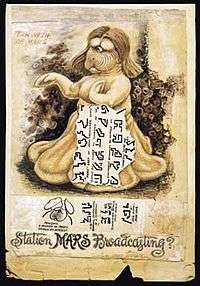Grant Wallace
Grant Wallace (1867–1954) was an American journalist, artist, screenwriter, Esperantist and occultist.
Early life
Grant Wallace was born on February 10, 1867, in Hopkins, Missouri, the son of a judge. His education included a B.S. from Western College in Shenandoah, Iowa, in 1889, and art classes from the Art Students League of New York.
He worked as an artist and reporter for the San Francisco Examiner, an editorial and feature writer for the San Francisco Chronicle, and a war correspondent for the Evening Bulletin in Japan and China. He wrote short stories and screen plays, including for two black and white silent movies: the story for A Blowout at Santa Banana (1914), and the scenario for the movie The Fuel of Life (1917). He also lectured on the occult.

In this period he was also a promoter of the international language esperanto and he was the editor of the San Francisco Esperantist.[1]
Occultism
After World War I, Wallace built a small cabin in the forest near Carmel, California, which he used as a laboratory for experimenting with telepathy, which he sometimes referred to as "mental radio." He made hundreds of drawings, charts, diagrams, and writings, attempting to reveal the patterns of life, including reincarnation, communication with intelligent life on other planets, and with dead spirits. He wrote about messages from the dead, from ancient Greeks, ancient Egyptians, Vikings, and Atlanteans, to more recent dead, such as Thomas Jefferson and Charles Darwin, and transcribed messages from and drew pictures of extraterrestrial life, especially from the Pleiades star cluster.
He died August 12, 1954, in Berkeley, California. His works were recovered from his cabin after his death, and some of his art and diagrams were included in The End is Near!, Visions of Apocalypse, Millennium and Utopia, ISBN 0-9664272-7-0, published by Dilettante Press.
References
- "ESPERANTISTS TO MEET Bay Cities Linguists to Assemble in Oakland Thursday". San Francisco Call. 23 December 1923.
- Dilettante Press Page with bio and photos, by the publishers of "The End is Near", featuring many of his drawings and diagrams of the supernatural.
- Grant Wallace on IMDb
- The Fuel of Life Page on the movie by the AFI silent film catalog